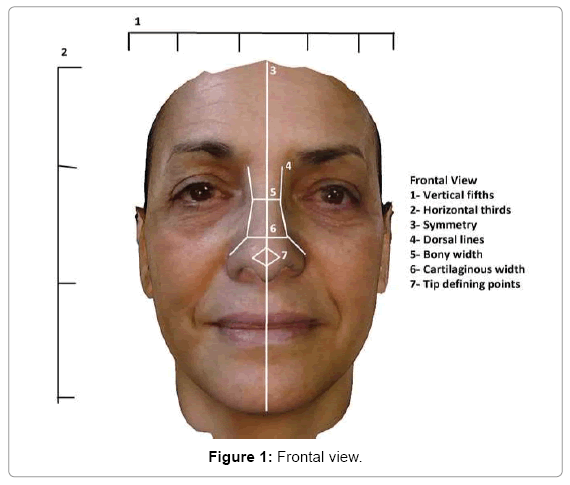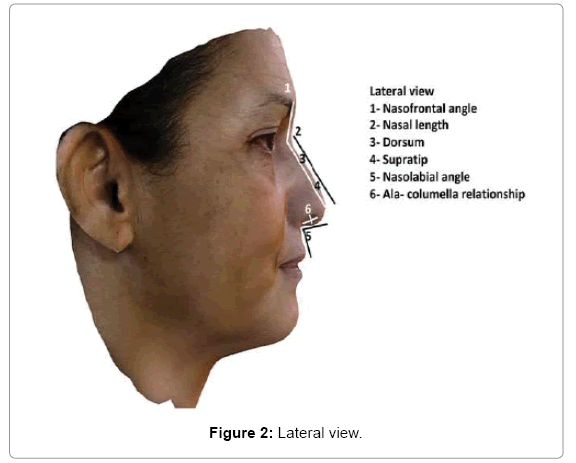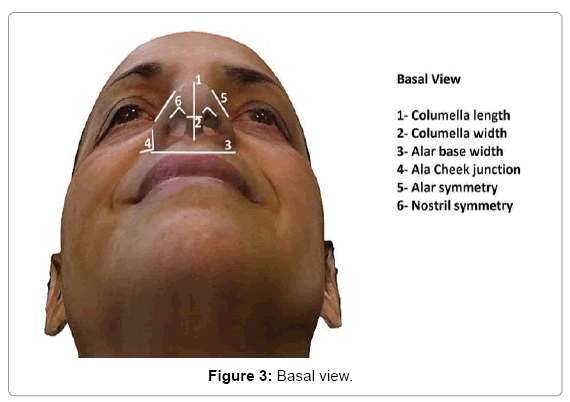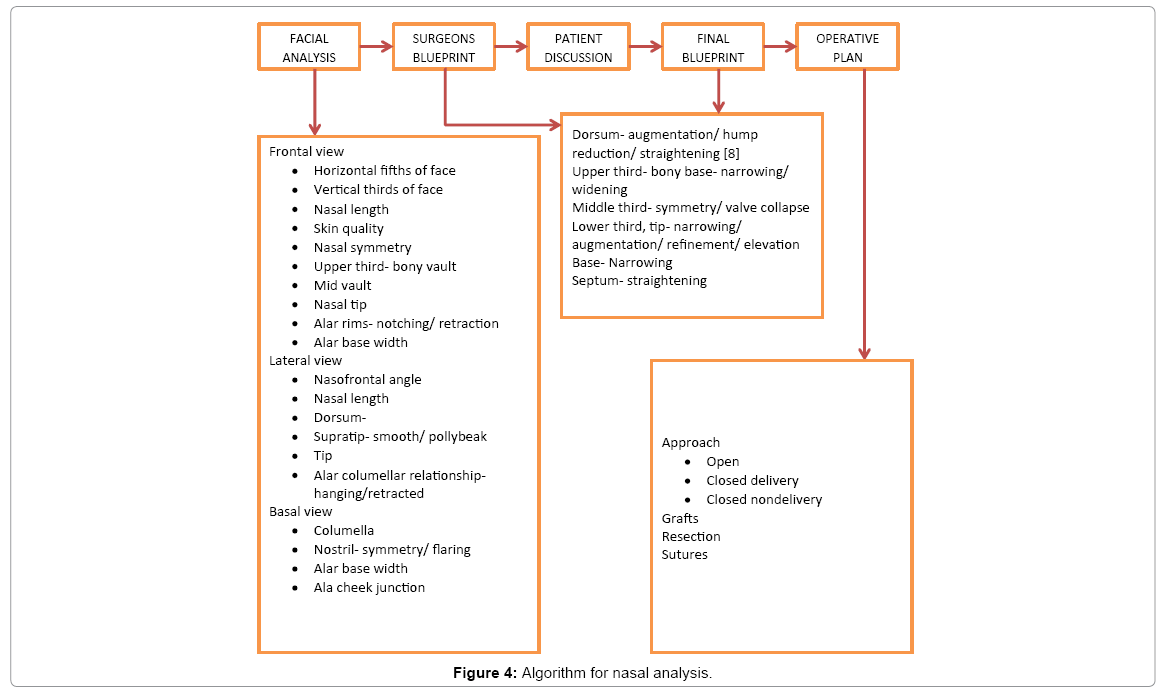Structured Analysis of Nose to Achieve Natural Results in Rhinoplasty
Received: 13-Feb-2017 / Accepted Date: 22-Feb-2017 / Published Date: 28-Feb-2017 DOI: 10.4172/2161-119X.1000293
Abstract
Rhinoplasty is one of the tenets of plastic surgery that can be considered a perfect marriage of art and science. The importance of proper planning and analysis cannot be overstated. In our paper, we will aim to offer a structured analysis of the nose, as well as elucidate how to derive an operative plan, in order to achieve the most natural and long lasting results. Our analysis consists of facial analysis, surgeon’s blueprint, patient discussion, final blueprint and operative plan. Patient plays a significant role in planning as they guide the surgeon to what they are realistically looking for and expecting. It is important that the operative plan be as simple as possible to achieve the goals, and at the same time be flexible. With this algorithmic approach, it is possible to consistently deliver natural results.
Keywords: Rhinoplasty; Plastic surgery; Patient
254629Introduction
Rhinoplasty is one of the tenets of plastic surgery that can be considered a perfect marriage of art and science. For this reason, it has traditionally been regarded as one of the hardest skills to master, with something new to learn even for the most seasoned of surgeons. The outcome of a surgery depends on a number of factors, many of which aren’t in the surgeon’s control. Moreover the results seem soon after the surgery may change over the course of time, with surgeons realizing the value of planning for the long term, only later in their careers [1]. Also, the standards of beauty vary from race to race, and nowhere is this disparity more apparent than in rhinoplasty surgery [2]. For all these reasons, even the best knowledge, skill set and planning may not always lead to the desired outcome.
Patient plays a significant role in planning as they guide the surgeon to what they are realistically looking for and expecting. The surgeon’s assessment and plan has to match the patients expectation emphasizing on what is and what is not possible.
The Importance of proper analysis and planning
The importance of proper planning and analysis cannot be overstated. A rhinoplasty surgeon cannot be slave to one particular method or dogma, and must tailor his approach to each patient to achieve the desired outcome. Moreover, it is important to plan for the long term, anticipating changes that might occur post-surgery.
There is plenty of existing literature on various ideal facial proportions, measurements and angles [3,4]. However, often there is a lack of clarity on how to convert these measurements and values into an operative plan. In our paper, we will aim to offer a structured analysis of the nose, as well as elucidate how to derive an operat ive plan, in order to achieve the most natural and long lasting results.
Steps of Analysis
1) Facial analysis- This consists of analysis of the patients face with the established guidelines of aesthetics.
2) Surgeons blueprint- Once the analysis is done, the surgeon analyses all the improvements that can be done for the patient with his order of priority.
3) Patient discussion- Rhinoplasty must be a joint endeavor with the patient. The surgeon’s blueprint is discussed with the patient, taking the patients input on their concerns and priorities.
4) Final blueprint- The final operative blueprint is decided based on the surgeon’s advice as well as the patient’s priorities. In simple words this is a list of ‘what to do’.
5) Operative plan- The operative plan is designed to achieve the aims of the blueprint. In other words, this is a sequence of ‘how to do’.
Facial analysis
Facial analysis must be done form the frontal, lateral and basal views. The idea is to identify the external deformities, predict the internal anatomy and determine the appropriate intervention [5]. Here we summarize the essential features to be identified in each view [6,7].
Frontal view: The most important things to view are symmetry, balance and tip characteristics (Figure 1):
• Horizontal fifths of face- Alar base width
• Vertical thirds of face- Nasal length
• Skin quality
• Nasal symmetry
o Dorsal aesthetic lines- Deviations- S/C type
• Upper third- bony vault
o Width- narrow/wide
o Short or long nasal bones
• Mid vault
o narrow/wide
o Inverted V deformity
• Nasal tip
o Tip defining points
o Supratip break
o Infratip lobule
o Summary- bulbous/pinched/bifid
• Alar rims- notching/retraction
• Alar base width
Lateral view: Should be examined in the Frankfurt horizontal plane. The key is to identify anteroposterior relationships to complete the 3 dimensional analysis of the nose (Figure 2):
• Nasofrontal angle
o High/low radix
• Nasal length
• Dorsum- smooth/depression/hump
• Supratip- smooth/polly beak
• Tip
o Nasolabial angle
o Projection- over/under
o Rotation- over/under
• Alar columellar relationship- hanging/retracted
Basal view: The key points to identify are the columella and alar rims (Figure 3):
• Columella
o Width
o Flaring
o Columella lobule ratio
• Nostril- symmetry/flaring
• Alar base width
• Ala cheek junction
Other examination:
• Skin character- elasticity, texture
• Intranasal inspection
o Septum- deviation, amount of cartilage
o Turbinate- hypertrophy
o Cottles manoeuvre
Surgeon’s blueprint
Once the analysis is done, the surgeon creates a list of improvements that he feels can be made, keeping in mind the aesthetics for the patient’s particular race. He also ranks his priorities for these improvements. These can be arranged as follows:
Dorsum- augmentation/hump reduction/straightening [8]
Upper third- bony base- narrowing/widening
Middle third- symmetry/valve collapse
Lower third, tip- narrowing/augmentation/refinement/elevation [9]
Base- Narrowing
Septum- straightening
Patient discussion
Very often, an improvement that the surgeon deems necessary might not be a priority for the patient, and something the surgeon deems minor, might be the patient’s biggest concern. Ultimately it is the patient’s satisfaction that is paramount. Hence the surgeon’s blueprint must be discussed with the patient and adjusted according to the patient’s wishes and priorities. At the same time it is important not to acquiesce to the patients every request, as something the patient desires might be detrimental in the short and long run. It is also important to keep in mind the secondary effects of every surgical manoeuvre.
Final blueprint
Keeping all these factors in mind the final blueprint is agreed upon which should ideally be an ideal balance of the patient’s desires and surgeon’s advice (Figure 4).
Operative plan
The technical aspects of the operative plan are then decided to attain the goals of the blueprint. The most important decision is to decide the access and incision. As mentioned earlier, it is important not to be a slave to any one approach and to treat each case on its merits. Also the surgeon must aim to achieve his goals with the minimal required manoeuvres. The vasoconstriction of the local anaesthetic and the edema associated with a longer surgery might prevent the results of a technically skilled surgery from being visible.
Moreover every additional manoeuvre adds another variable during the healing phase [1].
Overview of Different Approaches [10]
The decision to decide between open or closed approach depends upon the anatomical areas that need to be focused, patient desire and expectations.
Open
Open tip rhinoplasty has advantages of direct visibility, control, precision and access to deep structures such as keystone area, anterior nasal spine and posterior and caudal part of the septum. The main disadvantages are edema, induration and fibrosis in the tip and supratip region and potentially visible scars in the columella. It may take several months before the final result is apparent. Intralesional triamcinolone may be needed to minimize internal scarring. If the patient requires significant tip changes such as soft tissue resection, cartilage trimming, dome reconstruction, supratip refinement and tip elevation open tip rhinoplasty gives us significant advantages. Special attention is required to suture the lateral part of columella to prevent constriction or step deformity.
Closed nondelivery
Closed rhinoplasty without delivery of cartilages are ideal for patient requiring septoplasty, bony base narrowing, hump reduction, dorsal augmentation and correction of deviated nose with significant tip asymmetry. However, patient with small nostrils may have limited access to all the regions of the nose. At the same time secondary rhinoplasty may be challenging too.
Closed delivery
Closed rhinoplasty with tip delivery is performed if lower lateral cartilages require modification. It is possible to some extent, to resect soft tissue, trim lower lateral cartilages, perform various tip sutures and add grafts where needed. The amount of tip edema and fibrosis is limited. But the outcome may not be as dramatic as expected. This increases the risk of minor asymmetries, suboptimal result, inadequate reconstruction of the tip and failure to elevate/rotate the tip if necessary.
In summary a patient with ectomorphic characteristic having large hump with or without deviation, with under projected tip may do well with closed rhinoplasty. On the contrary an endomorphic patient with short, broad, thick nose have better outcome with open tip rhinoplasty with adequate and precise soft tissue (SMAS) removal, upper and lower lateral cartilage manoeuvres, structural grafts and skin redrawing.
Over View of Different Graft Options [8]
On many occasions we may need additional material to build, augment or reconstruct the nose. The decision between autologous cartilage grafts versus synthetic material really depends upon which anatomical zone of nose needs improvement (i.e., dorsum vs. tip).
Dorsum of nose
Dorsum may require augmentation (subtle or significant) or correction for unevenness or asymmetry, or merely enhancement of dorsal aesthetic lines.
Synthetic materials are useful in my opinion in patients who require just augmentation of dorsum and tip or enhancement of dorsal aesthetic lines. It is easily possible to achieve this with closed approach.
Cartilage grafts are necessary if unevenness or asymmetry is a problem in the dorsum of the nose and particularly where tip also requires reconstruction.
Dorsum often requires straight, long and thick grafts that has minimal tendency to warp. Costal cartilage is the first choice provided patient is young (absence of calcification) and scar on chest is not a significant issue. Septal cartilage is the second choice provided a long graft can be harvested. Conchal grafts are not suitable for dorsum unless it is used to cover minor unevenness and it is better used along with fascia (with or without dicing). A long straight and thick graft is more predictable in long run then small and diced cartilages.
Tip of nose
The tip can be reconstructed with any cartilage that is easily retrievable including resected LLC. Only columellar strut and lateral alar spanning cartilages require length and strength. Hence septal cartilage or conchal cartilage is a good source.
In some cases synthetic materials (silicone, proplast, polydioxanone plates) can be used in combination with cartilage grafts to provide strength and stability to columella. Obviously it requires open approach to ensure proper exposure, placement and coverage to prevent extrusions.
If tip and dorsum of nose requires augmentation or reconstruction then costal cartilage alone may suffice or a combination of septal and conchal may be required, sometimes additionally some synthetic materials.
The surgical options for each improvement are summarized in Table 1.
| Feature | Finding | Improvement | Plan |
|---|---|---|---|
| Dorsum | Depression | Augmentation | Grafts |
| Hump | Hump reduction | Rasping/osteotomy | |
| Deviation | Straightening | Grafts | |
| Upper third | Wide | Narrowing | Osteotomies |
| Narrow | Widening | Osteotomies | |
| Middle third | Asymmetry | Symmetry | Grafts, sutures |
| Valve collapse | Spreader graft | ||
| Lower third | Bulbous tip | Narrowing | Tip sutures, Cephalic trim |
| Depressed tip | Augmentation | Tip graft | |
| Ill-defined tip | Projection | Columellar strut | |
| Elevation | |||
| Bifid tip | Refinement | Tip sutures | |
| Alar collapse | Alar strut | ||
| Base | Alar flaring | Narrowing | Weir excision |
| Columellar support | Columella strut | ||
| Septum | Deviation | Straightening |
Table 1: Surgical options for each improvement.
Conclusion
Although rhinoplasty is a daunting surgery, a proper structural analysis of the nose can help achieve natural results. As described above, a detailed analysis is converted to a blueprint in keeping with the patients desires, from which an operative plan is evolved. The outcomes of rhinoplasty surgery are revealed over the course of years, as the effect of forces of scarring and soft tissue contracture is revealed. It is important that the operative plan be as simple as possible to achieve the goals and at the same time be flexible. A one size fits all approach will yield inadequate results and must be avoided.
References
- Williams EF 3rd, Lam SM (2002) A systematic, graduated approach to rhinoplasty. Facial Plast Surg 18: 215-222.
- Broer PN, Buonocore S, Morillas A, Liu J, Tanna N, et al. (2012) Nasal aesthetics: A cross-cultural analysis. Plast Reconstr Surg 130: 843e-850e.
- Tardy ME Jr, Dayan S, Hecht D (2002) Preoperative rhinoplasty: Evaluation and analysis. Otolaryngol Clin North Am 35: 1-27.
- Woodard CR, Park SS (2010) Nasal and facial analysis. Clin Plast Surg 37: 181-189.
- Toriumi DM (2005) Rhinoplasty. In: Park SS (eds.) Facial plastic surgery: The essential guide. Thieme Medical Publishers: New York, pp: 223-253.
- Burres S (1999) Tip points: Defining the tip. Aesthetic Plast Surg 23: 113-118.
- Powell N, Humphreys B (1984) Proportions of the aesthetic face. Thieme-Stratton, New York.
- Toriumi DM (2000) Autogenous grafts are worth the extra time. Arch Otolaryngol Head Neck Surg 126: 562-564.
- Toriumi DM (2006) New concepts in nasal tip contouring. Arch Facial Plast Surg 8: 156-185.
- Conrad K (1986) Cartilage delivery and open rhinoplasty as two preferred approaches to the nasal tip. J Otolaryngol Suppl 15: 1-24.
Citation: Parashar S, Venkataram A (2017) Structured Analysis of Nose to Achieve Natural Results in Rhinoplasty. Otolaryngol (Sunnyvale) 7:293. DOI: 10.4172/2161-119X.1000293
Copyright: © 2017 Parashar S, et al. This is an open-access article distributed under the terms of the Creative Commons Attribution License, which permits unrestricted use, distribution, and reproduction in any medium, provided the original author and source are credited.
Share This Article
Recommended Journals
Open Access Journals
Article Tools
Article Usage
- Total views: 6454
- [From(publication date): 0-2017 - Mar 31, 2025]
- Breakdown by view type
- HTML page views: 5555
- PDF downloads: 899




